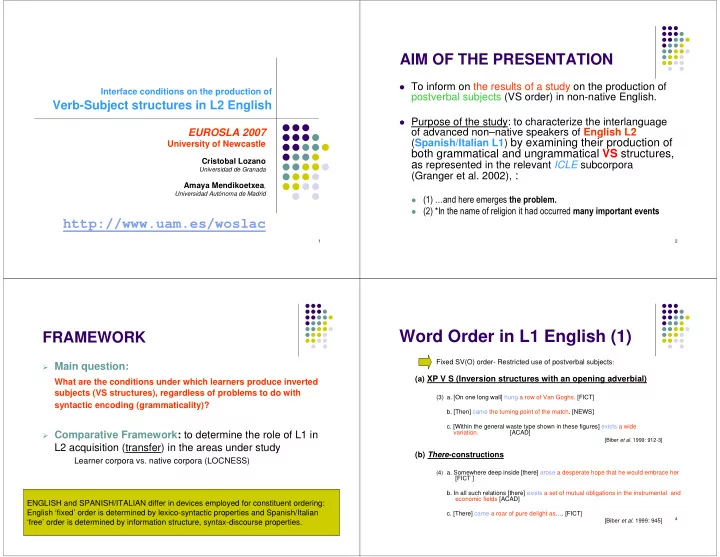

AIM OF THE PRESENTATION � To inform on the results of a study on the production of Interface conditions on the production of postverbal subjects (VS order) in non-native English. Verb-Subject structures in L2 English � Purpose of the study: to characterize the interlanguage of advanced non–native speakers of English L2 EUROSLA 2007 ( Spanish/Italian L1 ) by examining their production of University of Newcastle both grammatical and ungrammatical VS structures, Cristobal Lozano a s represented in the relevant ICLE subcorpora Universidad de Granada (Granger et al. 2002), : Amaya Mendikoetxea , Universidad Autónoma de Madrid � ���������������������� ������������ � ����������� ���� �� �������� �� ��� �������� ���� ��������� ������ http://www.uam.es/woslac 1 2 Word Order in L1 English (1) FRAMEWORK Fixed SV(O) order- Restricted use of postverbal subjects : � Main question: (a) XP V S (Inversion structures with an opening adverbial) What are the conditions under which learners produce inverted subjects (VS structures), regardless of problems to do with (3) a. [On one long wall] hung a row of Van Goghs. [FICT] syntactic encoding (grammaticality)? b. [Then] came the turning point of the match. [NEWS] c. [Within the general waste type shown in these figures] exists a wide � Comparative Framework: to determine the role of L1 in variation. [ACAD] [Biber et al. 1999: 912-3] L2 acquisition (transfer) in the areas under study (b) There -constructions Learner corpora vs. native corpora (LOCNESS) (4) a. Somewhere deep inside [there] arose a desperate hope that he would embrace her [FICT ] b. In all such relations [there] exists a set of mutual obligations in the instrumental and economic fields [ACAD] ENGLISH and SPANISH/ITALIAN differ in devices employed for constituent ordering: English ‘fixed’ order is determined by lexico-syntactic properties and Spanish/Italian c. [There] came a roar of pure delight as…. [FICT ] 3 4 [Biber et al. 1999: 945] ‘free’ order is determined by information structure, syntax-discourse properties.
Word order in L1 English (VS order) Word Order L1 Spanish/Italian (1) Postverbal subjects are produced ‘freely’ with all verb classes: Lexicon-syntax interface (Levin & Rappaport-Hovav, etc): � Unaccusative Hypothesis (Burzio 1986, etc) [existence and appearance] � (9) a. Ha telefoneado María al presidente. (transitive). ��� ������� ���� �������������������������� ���������� ���� Has phoned Mary the president �!������� ������� ���������������������������� ������������� ���� b. Ha hablado Juan . Ha llegado Juan (unergative) c. (unaccusative) has spoken Juan . has arrived Juan Syntax-discourse interface (Biber et al , Birner 1994, etc): � Postverbal material tends to be focus / relatively unfamiliar information, � Inversion as ‘ focalisation ’: • while preverbal material links S to previous discourse. preverbal subjects are topics (given information) � �"��#�������������������$����������%��������������&����������������$���� ������������������� and postverbal subjects are focus (new information) (Belletti 2001, 2004, � Zubizarreta 1998) Syntax-Phonological Form (PF) interface (Arnold et al 2000, etc) � Heavy material is sentence-final ( Principle of End-Weight , Quirk et al . � (10) ¿ Quién ha llegado/hablado? (Sp) (11) Chi è arrivato/parlato? (It) 1972) – general processing mechanism (reducing processing burden) Who has arrived/spoken? �'��(���)����$�������������*���������������������+ ���,+ �������������������������$��������$� i. Ha llegado/hablado Juan i. É arrivato/ A parlato Gianni �����$������������� �-����.����/� ����������������������������� 0�����1�2������ ii. # Juan ha llegado/hablado ii. # Gianni é arrivato/a parlato Subjects which are focus, long and complex tend to occur postverbally in those 5 6 structures which allow them (unaccusative Vs). Word Order L1 Spanish/Italian The phenomenon in SLA (VS order) Production of postverbal subjects in L2 English � Lexicon-syntax interface (Zobl 1989, Rutherford 1989, Oshita 2004) 3��������������1����������� ���4�����������*�������������������� L1 Spanish/Italian/Arabic – L2 English: � ����������������� ������������������������ � � Syntax-discourse interface ��5��&���������������������� ������������� � ��6���������$�������$��7���� ��������� 2��������� ���4��������)���������������������������� ����������������*���������������� �������������� *�������������$����� � Syntax-Phonological Form (PF) interface Only with unaccusative verbs (never with unergatives). � Heavy subjects show a tendency to be postposed – a universal Unaccusatives: arrive, happen, exist, come, appear, live … � Unergatives: cry, speak, sing, walk ... language processing mechanism: placing complex elements at � the end of a sentence reduces the processing burden (J. Hawkins 1994). Explanation : lexicon-syntax interface ( Unaccusative Hypothesis ) � Subjects which are focus, long and complex tend to occur postverbally, with no 7 8 restrictions at the lexicon-syntax interface.
Recommend
More recommend